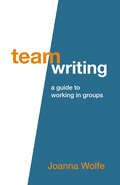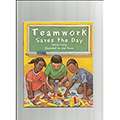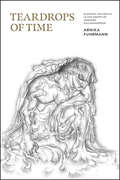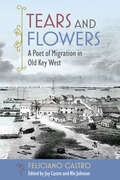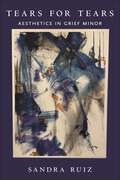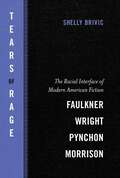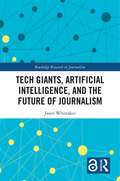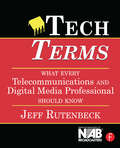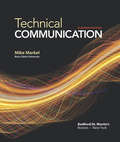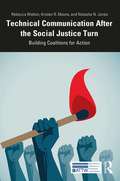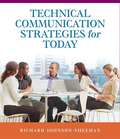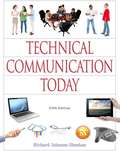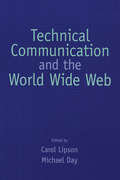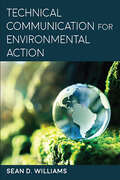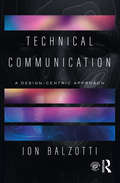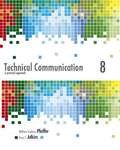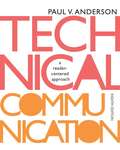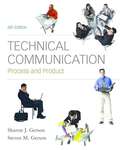- Table View
- List View
Team Writing: A Guide to Working in Groups
by Joanna WolfeBuilt around real group interactions, Team Writing is a flexible, hybrid resource that pairs videos with a brief print book. Based on research revealing major problems at all stages of peer group work, the book shows how written communication can help technical writing students contribute to team projects in a meaningful way — and provides strategies for dealing with the breakdowns that can derail a project’s success. Numerous examples highlight the kind of written communication that helps teams thrive. Short, Web-based videos depict student teams in action, going beyond the textbook to show what real collaboration looks and sounds like.
Teams Work Together (Reach Into Phonics Ser.)
by Deborah J. Short Joanna Korba Will JimmersonNIMAC-sourced textbook
Teardrops of Time: Buddhist Aesthetics in the Poetry of Angkarn Kallayanapong
by Arnika FuhrmannFocusing on one of the most significant poets of the twentieth century, Angkarn Kallayanapong (1926–2012), this book makes a unique contribution to understandings of non-Western literary modernity. Arnika Fuhrmann investigates how the Thai poet adapts Buddhist understandings of time to create a modern Asian aesthetic imaginary. While Angkarn's poetry conjures the image of an early modern Thai cosmopolitanism, it also pioneers a poetics reflective of present-day globalization. The result is an experiment in Buddhist cosmopolitan aesthetic modernity. Teardrops of Time contextualizes the poet's work in the literary history and cultural politics of his time, tracing the transformation of a modern Thai cultural and political imaginary through the political history of the country's authoritarian governance since the late 1950s and the exigencies of an increasingly globalized economy since the 1980s. As Angkarn's work aligns itself with contemporaneous global trends in poetry, the book reads it alongside the work of Paul Celan and Allen Ginsberg.
Tears and Flowers: A Poet of Migration in Old Key West
by Feliciano CastroA bilingual edition of poetry that provides a unique window into Cuban émigré life A rare glimpse into the history of the Cuban community in Key West in the early twentieth century, this book makes the poetry of Feliciano Castro available in English for the first time. A Galician Cuban who lived for decades in the southernmost city of the United States, Castro worked as a lector reading to cigar factory employees, a newspaper editor, a printer, and a writer. He published Lágrimas y flores, a collection of his poetry, in 1918. Translated here by Rhi Johnson, Castro’s poems provide a window into an overlooked literary culture.Johnson and Joy Castro open this bilingual edition with an introduction detailing the writer’s biography, literary context, and cultural milieu. Tears and Flowers highlights questions of national identity, migration, belonging, and courtship in Cuban émigré society, connects Florida to the Spanish-speaking communities of the Caribbean and Spain, and recovers the literary archive of a rich moment in US and Latinx history for a contemporary audience. Publication of this work made possible by a Sustaining the Humanities through the American Rescue Plan grant from the National Endowment for the Humanities.
Tears for Tears: Aesthetics in Grief Minor (Minoritarian Aesthetics)
by Sandra RuizHow minoritarian artists grapple with both personal and collective griefTears for Tears documents moments of tension, negotiation, transformation, and incommensurability between singular loss and mass death through the work of contemporary minoritarian artists. These artists interrogate the cultural, social, and political enmeshment of death by questioning the interior and exterior conditions of loss Charting communal, singular, ongoing, and impending loss due to state-sanctioned violence, colonial racial capitalism, natural disaster, and social and personal circumstances, Sandra Ruiz underscores the affective entanglements across death that reshape the topography of grief into portals of possibility.Drawing from original interviews, familial artifacts, images, and personal archival notes of artists—much of which have never been written about before—the project centers the minoritarian artist as living with and against death in everyday life and art practice. In doing so, the manuscript stages an archival and ideological intervention into the life of grief for minoritarian subjects and artists.Moving across performance and video art, sculpture, dance, music, theatre, and poetry, Ruiz highlights the relationship between everyday life and staged events as a critical lens to rethink structures of colonial and imperial spatial temporalities of grief. Offering invaluable insights into the production of these works and performances, Ruiz reveals how these artists move across social, corporeal, and psychic constructions of sorrow in their art practices—often working from parental loss into the domain of communal death—and see grieving, however painful, as an act of empowerment, transformation, growth, and communal building.
Tears of Rage: The Racial Interface of Modern American Fiction-Faulkner, Wright, Pynchon, Morrison (Southern Literary Studies)
by Dan Rather Shelly BrivicIn this provocative study, Shelly Brivic presents the history of the twentieth-century American novel as a continuous narrative dialogue between white and black voices. Exploring four of the most renowned and challenging works written between 1930 and 1990 -- William Faulkner's Absalom, Absalom!, Richard Wright's Native Son, Thomas Pynchon's V., and Toni Morrison's Beloved -- Brivic traces how these works progress through the interaction of white and black perspectives toward confronting the calamity of slavery and its reverberating aftermath and continuing legacy. Brivic shows how one novel leads ineluctably to the next and how the four works in a sense form one continuous narrative: with Faulkner's attack on the racial system in Absalom, Absalom! in the 1930s, a literary space opened for Wright's devastating novel of protest. Through the character of Bigger Thomas, Wright's Native Son exposes a virtually incurable division in American ideologies, which leads to the multiplying perspectives of postmodernism in Pynchon's V. Arriving at the crest of the civil rights movement, V. questions Western systems of control, laying a foundation for a world outside the white one, and so providing a basis for the African view of reality presented in Morrison's Beloved. The emergence of African consciousness in American literature exemplified across these works has had, and continues to have, Brivic concludes, the potential not only to redress ongoing injustices but to bring about a new conception of the American universe and its laws of reality. Striking in both the selection of novels and the connections Brivic draws among them, Tears of Rage advances understanding of the destructive nature of racism and the possibilities for overcoming its effects through literature.
Tech Giants, Artificial Intelligence, and the Future of Journalism (Routledge Research in Journalism)
by Jason Paul WhittakerThis book examines the impact of the "Big Five" technology companies – Apple, Alphabet/Google, Amazon, Facebook and Microsoft – on journalism and the media industries. It looks at the current role of algorithms and artificial intelligence in curating how we consume media and their increasing influence on the production of the news. Exploring the changes that the technology industry and automation have made in the past decade to the production, distribution and consumption of news globally, the book considers what happens to journalism once it is produced and enters the media ecosystems of the internet tech giants – and the impact of social media and AI on such things as fake news in the post-truth age. The audience for this book are students and researchers working in the field of digital media, and journalism studies or media studies more generally. It will also be useful to those who are looking for extended case studies of the role taken by tech giants such as Facebook and Google in the fake news scandal, or the role of Jeff Bezos in transforming The Washington Post. The Open Access version of this book, available at https://doi.org/10.4324/9781351013758, has been made available under a Creative Commons Attribution-Non Commercial-No Derivatives 4.0 license.
Tech Terms: What Every Telecommunications and Digital Media Professional Should Know
by Jeff RutenbeckAn avalanche of acronyms, terms-of-art, buzz words, and short-hand phraseology confronts today's busy communications professionals. Now in its 3rd edition, Tech Terms is an invaluable learning tool to help grasp key aspects of the television and video, PC hardware and software markets, multimedia authoring tools, and the exploding wireless Internet and mobile telecomputing worlds. With more than 1000 terms described in four sentences or less, Tech Terms is perfect the perfect desk reference.
Technical Communication
by Mike MarkelInstructors know that Mike Markel's Technical Communication will prepare their students for any workplace writing situation. No other text offers such a comprehensive introduction to the field while still delivering practical, effective support for students at every level. The eleventh edition has been thoroughly revised to reframe the work of technical communicators in the context of today's highly collaborative, rapidly evolving digital practices. Fresh, social-media driven sample documents and coverage of the latest tools and technologies ensure that students work with the kinds of processes and products they'll encounter on the job.
Technical Communication After the Social Justice Turn: Building Coalitions for Action (ATTW Series in Technical and Professional Communication)
by Rebecca Walton Kristen Moore Natasha JonesThis is the first scholarly monograph marking the social justice turn in technical and professional communication (TPC). Social justice often draws attention to structural oppression, but to enact social justice as technical communicators, first, we must be able to trace daily practice to the oppressive structures it professionalizes, codifies, and normalizes. Technical Communication After the Social Justice Turn moves readers from conceptual explorations of oppression and justice to a theoretical framework that allows for the concepts to be applied and implemented in a variety of practical contexts. It historicizes the recent social justice turn in TPC scholarship, models a social justice approach to building theories and heuristics, and presents scenarios that illustrate how to develop sustainable practices of activism and social justice. Its commitment to coalition building, inclusivity, and socially just practices of citation and activism will support scholars, teachers, and practitioners not only in understanding how the work of technical communication is often complicit in oppression but also in recognizing, revealing, rejecting, and replacing oppressive practices.
Technical Communication Strategies for Today
by Richard Johnson-SheehanTechnical Communication Strategies for Today offers students all of the topics and genres they need for their technical communication course. Students want their textbooks to cost less, and they want comprehensive topical coverage presented in a succinct and clear writing style. Technical Communication Strategies for Today offers both and speaks to today's students. Instructional narrative is "chunked," so that portions of text are combined with graphics. The chunked presentation also integrates an awareness of how documents are read-often skimmed by readers seeking the information they need, and it models the way today's technical documents should be designed. The contemporary writing style is matched by an approach that accurately reflects the modern day computer-centered technical workplace: Technical Communication Strategies for Today presents computers as thinking tools that powerfully influence how we develop, produce, design, and deliver technical documents and presentations.
Technical Communication Today (Fifth Edition)
by Richard Johnson-SheehanTechnical Communication Today was written for introduction to technical communication or technical writing courses taught most often in English Departments. Technical Communication Today remains the only text to fully centralize the computer in the technical workplace, presenting how writers use computers throughout their communication process. Writers use their computers to help them think, research, compose, design, and edit. Not only is Technical Communication Today firmly rooted in core rhetorical principles, but the text also presents computers as thinking tools that powerfully influence how we develop, produce, design, and deliver technical documents and presentations. Technical Communication Today speaks to today's students and how they expect to learn information. Instructional narrative is "chunked," so that readable portions of text are combined with graphics. This presentation facilitate learning, and models the way today's technical documents should be designed. Additionally, the chunked presentation integrates an awareness of how documents are read--often "raided" by readers seeking the information they need. By mirroring these processes in its content and structure, Technical Communication Today offers readers a higher level of accessibility.
Technical Communication and the World Wide Web
by Michael Day Carol LipsonOver the past decade, the World Wide Web has dramatically changed the face of technical communication, but the teaching of writing has thus far altered very little to accommodate this rapidly changing context. Technical Communication and the World Wide Web offers substantial and broadly applicable strategies for teaching global communication issues affecting writing for the World Wide Web.Editors Carol Lipson and Michael Day have brought together an exceptional group of experienced and well-known teacher-scholars to develop this unique volume addressing technical communication education. The chapters here focus specifically on curriculum issues and the teaching of technical writing for the World Wide Web, contributing a blend of theory and practice in proposing changes in curriculum and pedagogy. Contributors offer classroom examples that teachers at all levels of experience can adapt for their own classes. The volume provides comprehensive coverage of the technical communication curriculum, from the two-year level to the graduate level; from service courses to degree programs.This volume is an important and indispensable resource for technical writing educators, and it will serve as an essential reference for curriculum and pedagogy development in technical communication programs.
Technical Communication for Environmental Action (SUNY series, Studies in Technical Communication)
by Sean D. WilliamsClimate change is one of the most significant challenges facing the global community in the twenty-first century. With its position at the border of people, technology, science, and communication, technical communication has a significant role to play in helping to solve these complex environmental problems. This collection of essays engages scholars and practitioners in a conversation about how the field has contributed to pragmatic and democratic action to address climate change. Compared to most prior work—which offers theoretical perspectives of environmental communication—this collection explores the actual practice of international technical communicators who participate in government projects, corporate processes, nonprofit programs, and international agency work, demonstrating how technical communication theories such as participatory design, social justice, and ethics can help shape pragmatic environmental action.br>SUNY Press has collaborated with Knowledge Unlatched to unlock KU Focus Collection titles. The Knowledge Unlatched titles have been made open access through libraries coming together to crowd fund the publication cost. Each monograph has been released as open access making the eBook freely available to readers worldwide. Discover more about the Knowledge Unlatched program here: https://www.knowledgeunlatched.org/. It can also be found in the SUNY Open Access Repository at <a href="https://soar.suny.edu/handle/20.500.12648/8482 ">https://soar.suny.edu/handle/20.500.12648/8482 .
Technical Communication: A Design-Centric Approach
by Jon BalzottiTechnical Communication: A Design-Centric Approach is a comprehensive textbook for introductory courses in technical communication and professional writing. Technical Communication takes a design approach to foundational and emergent technical communication skills such as document design, job applications and interviews, workplace collaboration, and report writing, providing students with practical guidance on matters of ethics, style, and problem-solving in a range of professional and organizational contexts. This is a core textbook suitable for undergraduate courses in technical and professional communication. The book is supplemented by an innovative website featuring interactive simulations of various real-world technical communication challenges. Visit https://microcore.byu.edu/
Technical Communication: A Design-Centric Approach
by Jon BalzottiTechnical Communication: A Design-Centric Approach is a comprehensive textbook for introductory courses in technical communication and professional writing. Technical Communication takes a design approach to foundational and emergent technical communication skills such as document design, job applications and interviews, workplace collaboration, and report writing, providing students with practical guidance on matters of ethics, style, and problem-solving in a range of professional and organizational contexts. This is a core textbook suitable for undergraduate courses in technical and professional communication.The book is supplemented by an innovative website featuring interactive simulations of various real-world technical communication challenges. Visit https://microcore.byu.edu/
Technical Communication: A Guided Approach
by June Dostal Deborah St VincentStudents practice as they learn to utilize and refine their reading, writing, listening, and speaking skills. They also learn how to write business documents, develop editing skills, practice teamwork, solve problems, develop a portfolio, use leadership skills, and learn to interact with other people.
Technical Communication: A Guided Approach
by June Dostal Deborah St VincentStudents practice as they learn to utilize and refine their reading, writing, listening, and speaking skills. They also learn how to write business documents, develop editing skills, practice teamwork, solve problems, develop a portfolio, use leadership skills, and learn to interact with other people.
Technical Communication: A Practical Approach
by Kaye E. Adkins William Sanborn PfeifferEmphasizing the connection between writing and context, Technical Communication: A Practical Approach 8e uses a fictional company (M-Global) and students' own school and workplace settings to introduce the common genres of technical communication. Featuring numbered guidelines and an ABC format, the book shows how to write a variety of technical documents including business proposals, white papers, scripts, research reports, digital documents and more!
Technical Communication: A Reader-Centered Approach (Eigthth Edition)
by Paul V. AndersonThe book intends to improve the students' writing and design skills.Also includes new learning outcomes at the start of each chapter to help students gain more from their reading.
Technical Communication: Process and Product (6th edition)
by Sharon J. Gerson Steven M. GersonThis 6th edition of Technical Communication: Process and Product guides readers through the entire writing process -- pre-writing, writing, and rewriting -- developing an easy-to-use, step-by-step technique for writing the types of documents they will encounter on the job.
Technical Editing: An Introduction to Editing in the Workplace
by Donald H. Cunningham Edward A. Malone Joyce M. RothschildTechnical Editing: An Introduction to Editing in the Workplace offers the most comprehensive, accessible, and current approach to technical and professional editing. <p><p>Written by an experienced author team, the first part of the text provides an overview of the editing process (appraising the document, creating an editing plan, and implementing the plan), the second part covers substantive editing (editing for organization, completeness, accuracy, etc.), and the third part explains copyediting (from its principles and procedures to their application in practice) and proofreading. <p><p>The authors discuss such topics as fraud in the workplace and whistleblowing; navigation aids in print and digital documents; redaction of classified or confidential information; layout and design principles; controlled languages, the plain English movement, and international varieties of English; content reuse and content management systems; and electronic editing skills. The book provides ample coverage of grammar, punctuation, and usage, with many authentic examples from technical and business documents.
Technical Ekphrasis in Greek and Roman Science and Literature
by Courtney RobyEkphrasis is familiar as a rhetorical tool for inducing enargeia, the vivid sense that a reader or listener is actually in the presence of the objects described. This book focuses on the ekphrastic techniques used in ancient Greek and Roman literature to describe technological artifacts. Since the literary discourse on technology extended beyond technical texts, this book explores 'technical ekphrasis' in a wide range of genres, including history, poetry, and philosophy as well as mechanical, scientific, and mathematical works. Technical authors like Philo of Byzantium, Vitruvius, Hero of Alexandria, and Claudius Ptolemy are put into dialogue with close contemporaries in other genres, like Diodorus Siculus, Cicero, Ovid, and Aelius Theon. The treatment of 'technical ekphrasis' here covers the techniques of description, the interaction of verbal and visual elements, the role of instructions, and the balance between describing the artifact's material qualities and the other bodies of knowledge it evokes.
Technical Report Writing Today
by Daniel RiordanTECHNICAL REPORT WRITING TODAY provides thorough coverage of technical writing basics, techniques, and applications. Through a practical focus with varied examples and exercises, students internalize the skills necessary to produce clear and effective documents and reports. Project worksheets help students organize their thoughts and prepare for assignments, and Focus boxes highlight key information and recent developments in technical communication. Extensive individual and collaborative exercises expose students to different kinds of technical writing problems and solutions. Annotated student examples--more than 100 in all--illustrate different writing styles and approaches to problems. Numerous short and long examples throughout the text demonstrate solutions for handling writing assignments in current career situations. The four-color artwork in the chapter on creating visuals keeps pace with contemporary workplace capabilities. The Tenth Edition offers the latest information on using electronic resumes and documenting electronic sources and Ethics and Globalization sidebars that highlight these two important topics in the technical communication field.
